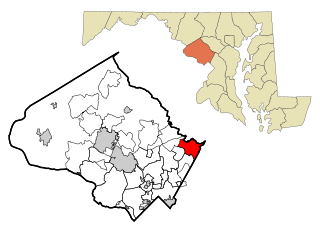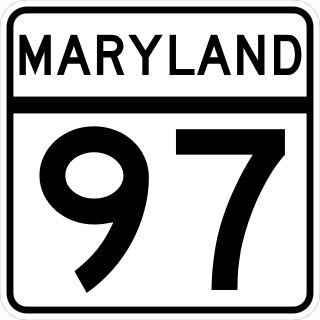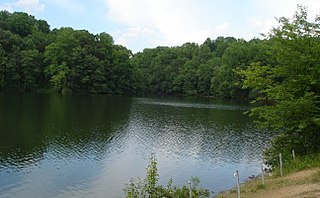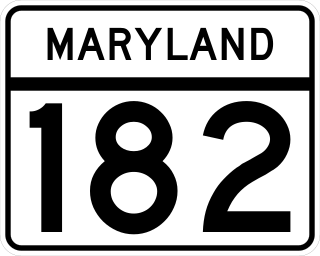
Olney is a U.S. census-designated place and an unincorporated area in Montgomery County, Maryland. It is located in the north central part of the county, ten miles (16 km) north of Washington, D.C.

Brookeville is a town in Montgomery County, Maryland, located 20 km (12 mi) north of Washington, D.C., and 2 km (1.2 mi) north of Olney. Brookeville was settled by Quakers late in the 18th century and was formally incorporated as a town in 1808. Historically part of the local agricultural industry, Brookeville is now at the northern edge of the densely developed Washington suburbs. The population was 166 at the 2020 census.

Burtonsville is a census-designated place and an unincorporated area in Montgomery County, Maryland, United States. It is situated in the northeast corner of Montgomery County, right on the border of both Howard and Prince George's counties. It is considered a suburban town in the Washington D.C. Metro Area.

Colesville is a census-designated place and an unincorporated area in Montgomery County, Maryland, United States. It had a population of 15,421 as of the 2020 census.

Glenmont is an unincorporated community and census-designated place in Montgomery County, Maryland, United States. The United States Census Bureau had combined Glenmont with nearby Wheaton to create the census-designated place of Wheaton-Glenmont, from 2000 to 2010. It had a population of 16,710 in 2020.

Maryland Route 108 is a state highway in the U.S. state of Maryland. The highway runs 34.23 miles (55.09 km) from MD 27 in Damascus east to MD 175 in Columbia. MD 108 is an S-shaped highway that winds through the northern Montgomery County and central Howard County. The highway connects the Montgomery County communities of Laytonsville, Olney, Sandy Spring, and Ashton with the Howard County villages of Highland and Clarksville. MD 108 serves as the northern edge of Columbia and connects several of the planned community's suburban villages.

Maryland Route 97 (MD 97) is a state highway in the U.S. state of Maryland. The route runs 55.27 mi (88.95 km) from U.S. Route 29 (US 29) in Silver Spring, Montgomery County, north to the Pennsylvania border in Carroll County, where the road continues into that state as Pennsylvania Route 97 (PA 97). Throughout most of Montgomery County, MD 97 is known as Georgia Avenue, which continues south from the southern terminus along US 29 into Washington, D.C. It is a suburban four- to six-lane divided highway from Silver Spring north to Olney. From here, the route continues as a rural two-lane undivided road north through Brookeville and into Howard County. MD 97 continues through Carroll County where it passes through the county seat of Westminster. The route intersects many major roads, including Interstate 495 north of Silver Spring, MD 28 and MD 200 in Norbeck, I-70/US 40 near Cooksville, MD 26 in Dorsey Crossroads, and MD 27, MD 32, and MD 140 in the Westminster area.

Maryland Route 650 is a state highway in the U.S. state of Maryland. Known as New Hampshire Avenue for most of its length, the state highway runs 25.89 mi (41.67 km) from Eastern Avenue at the Washington, D.C. border north to MD 108 in Etchison. MD 650 serves as a major north-south commuter route in northwestern Prince George's County and eastern Montgomery County, connecting the District of Columbia with the residential suburbs of Takoma Park, Langley Park, Adelphi, Hillandale, White Oak, and Colesville. By contrast, the part of MD 650 north of Spencerville is a quiet rural road connecting several small communities along the northeastern fringe of Montgomery County.
Norbeck is the area of Montgomery County, Maryland, United States, around Norbeck Road east of Georgia Avenue to Layhill Road. Shortly before the Civil War, free blacks founded Norbeck.

Triadelphia Reservoir is located on the Patuxent River, in Howard County and Montgomery County, Maryland near the town of Brookeville.

Maryland Route 182 is a state highway in the U.S. state of Maryland. Known for most of its length as Layhill Road, the highway runs 6.54 miles (10.53 km) from MD 97 in Glenmont north to MD 108 in Olney. MD 182 connects the northeastern Montgomery County communities of Glenmont, Layhill, Norwood, Sandy Spring, and Olney. The highway was constructed in the early 1920s. MD 182 was expanded to a four-lane divided highway from Glenmont to the site of its interchange with MD 200 in the late 1980s and early 1990s.

Clifton is a historic home located at Ednor, Montgomery County, Maryland, United States. It is a 1+1⁄2-story gambrel-roofed brick structure with a lower north wing, also with a gambrel roof. Outbuildings on the property include a wood-frame shed and a guest house or cottage. It is one of the few extant mid-18th-century buildings in Montgomery County and is associated with the local Quaker community, which by 1753 had been organized into the Sandy Spring Meeting of Friends.

The Sandy Spring Friends Meetinghouse is a historic building located at Sandy Spring, Montgomery County, Maryland. It is a large, Flemish bond brick, Federal-style Quaker Meeting House built in 1817. The meetinghouse is on two acres deeded by James Brooke in the 1750s, for the use of the Quaker Meeting. Nearby is the cemetery where he and many of his descendants were buried.

Caleb Bentley (1762–1851) was an American silversmith, shopkeeper, and first postmaster in Brookeville, Maryland. Bentley was born in Chester County, Pennsylvania in 1762.

The Brookeville Academy is located in the heart of the Historic District in Brookeville, Maryland, a town located twenty miles (32 km) north of Washington, D.C., and two miles (3.2 km) north of Olney in northeastern Montgomery County, Maryland. It was built in 1810 as one of the first private schools in Montgomery County, Maryland. Now, fully restored, it serves as a unique community center suitable for meetings, social and cultural events. It is located in the Brookeville Historic District, which served as the "Capital for a Day" in 1814 when President Madison had to flee the White House during the British Invasion of the War of 1812.
Richard Snowden (1688–1763) was the grandson of Richard Snowden Sr (1640–1711), one of Maryland's early colonists, who arrived in 1658. By Articles of Agreement dated July 5, 1705, Snowden and four other partners – Joseph Cowman, Edmund Jenings, John Galloway, and John Prichard – founded the Patuxent Iron Works on the site of Maryland's oldest iron forge. Together they founded one of Maryland's first industries, and settled the land now known as Laurel and Sandy Spring, Maryland.

Craig Jason Zucker is an American politician who serves in the Maryland Senate from the 14th Legislative District. The district includes parts or all of Silver Spring, Calverton, Colesville, Cloverly, Fairland, Burtonsville, Spencerville, Olney, Brookeville, Ashton, Sandy Spring, Brinklow, Laytonsville, Sunshine, Goshen, and Damascus in Montgomery County. He was elected to the Maryland House of Delegates on November 2, 2010, and sworn in on January 12, 2011, then re-elected in 2014 to his second-four-year term. On February 4, 2016, he was sworn into the Maryland State Senate following the retirement of Senator Karen S. Montgomery.

Norwood is an unincorporated community in Montgomery County, Maryland, United States, located at the intersection of Layhill Road, Norwood Road, and Ednor Road, two miles from the Intercounty Connector (ICC).
Isaac Briggs was an American engineer, surveyor and manufacturer. He lived much of his adult life with his family in Brookeville, Maryland.

Sandy Spring Museum was founded as a local history museum, preserving the history of the surrounding area of Sandy Spring, MD. Today, by supporting community-driven cultural arts and educational programs, they gather community to build a sense of place and belonging.




















